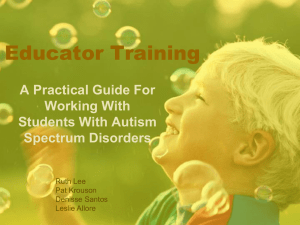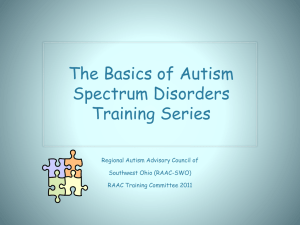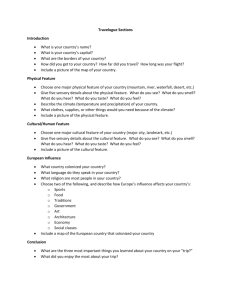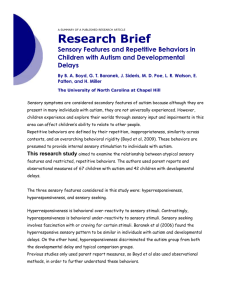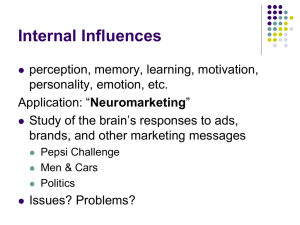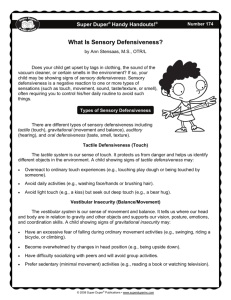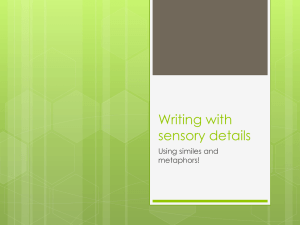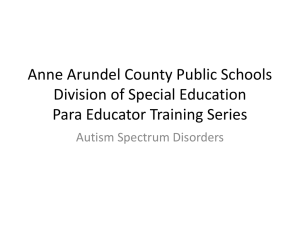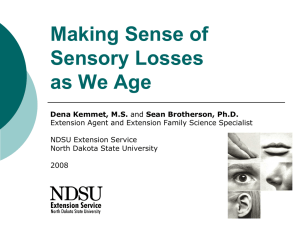Smookler_Feb2012 - Metro Speech Language Network
advertisement
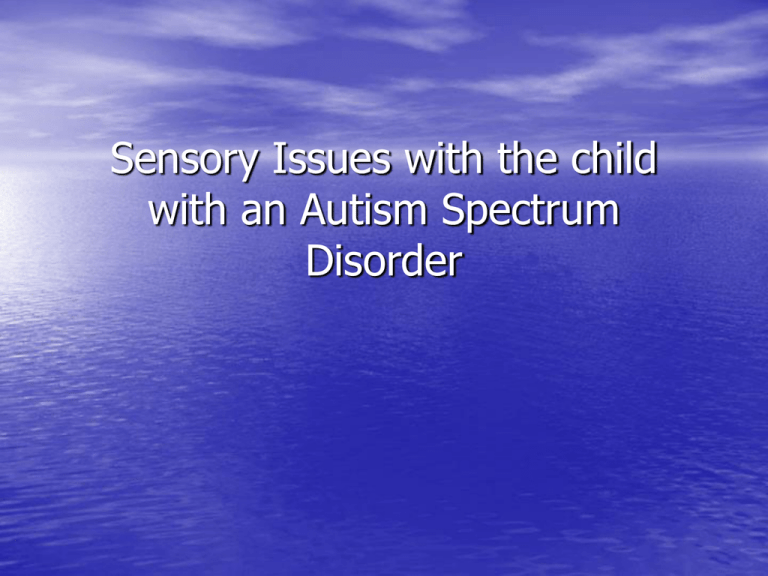
Sensory Issues with the child with an Autism Spectrum Disorder Why so many kids with Autism? • • • • • • Possible causes can include: Pruning during normal development Cell migration Brain stem structures Abnormal cerebellum, faulty volume control Hypothalamus issues related to body temperature, hunger, thirst, circadian rhythms and hormone regulation. Causes • Neurotransmitters play a role in sensory issues. Dopamine, norepinephrine and serotonin affect CNS and impact arousal, sleep, attention and motivation. • Recent studies have shown that children with Sensory Processing Problems have nervous system disturbances. Other Contributing Factors: • Genetics • Prematurity • Birth Trauma and Hospitalization • Adopted Children • Heavy Metals Ingested during Pregnancy Wake Up your senses! • Fast moving activity! • Activity analysis, what did we just do? • How fast our brains worked to make this happen? • Rapid firing neurotransmission taking place and of course we saw it as being fun because we were moving and thinking! Every Child with Autism Is Unique • ASD casts a wide net • What people on the spectrum do have in • common is that they almost always have significant sensory problems. Geneva Centre for Autism study in Toronto found 8 out of 10 were hypersensitive to touch and sound and had vision problems and nearly 1/3 had taste or smell sensitivities. Stanley Greenspan Study • 200 children with ASD 94% had sensory issues • • • • • including: 39% were underreactive( 28% did not respond to sensory stimuli while 11% engaged in sensory seeking behaviors) 19% were oversensitive 36 % both over AND undersensitive 100% had auditory processing dysfunction 100% had motor planning dysfunction ( 48 % with severe motor planning problems and 17% with low muscle tone and related problems) Significant Sensory Differences • Tactile Sensitivity • Taste/Smell Sensitivity • Movement Sensitivity • Under responsive/Seeks Sensation • Auditory Filtering • Low Energy/weak • Visual/Auditory Sensitivity Tactile Sensitivity • Would rather touch others than be touched by • • • • • others Fuss or resist hair washing/cutting/nail trims clothing changes/tags/labels/seams Crowds or body space/being bumped into Dirty or messy hands May seem unnecessarily rough Bump or crash into things seeking sensation or seem under responsive to certain sensations or pain Fun or yuck? Taste/Smell Sensitivity • Smell is primitive, we smell danger • Smell travels thru the Limbic system, which is the center of our emotions, memory, pleasure, and learning. • No other sense taps into our emotions like our sense of smell • Senses of taste and smell are intimately connected Common signs of Taste and Smell Sensitivity • Avoids most foods children their age enjoy • Have limited repertoire of accepted foods • Crave or become upset by certain smells or tastes • Hold their nostrils closed even when nothing smells bad to you • Gag, nauseated and even vomit at the sight of the food And this is just a typically developing child Oral Defensiveness • Avoid placing toys in their mouth • Refuse bottles or breast • Resulting in poor weight gain, use of g- tubes and long term feeding problems if gone un detected It starts even before this first spoonful Motor Homunculus Movement Sensitivity • Postural Insecurity this is the fear and avoidance of certain movement activities due to poor postural mechanisms. Gravitational Insecurity • Irrational fear of change of position or movement. These children are often fearful of having their feet leave the ground, or having their heads tipped backwards. Auditory Defensiveness • This reflects an over sensitivity to certain sounds and may involve irritable or fearful responses to noises like vacuum cleaners, motors, fire alarms, blow dryers. • Sometimes children may noise to block out these sounds and their attention can be disrupted because of these noises. It hurts my ears Visual Defensiveness • This may involve an oversensitivity to light and visual distractibility. • They may avoid going outside in certain light and may need sunglasses and hats to block out the light • They may startle more easily and appear to avoid eye contact. Identify the purpose of Self stimulating behaviors and how to address them • • • • • • • • • Coping Mechanisms Some more socially acceptable might include: Rationalization Ex: Creating a logical justification for an action. Buying a new outfit when you are broke to help you find a better job. Idealization Ex: Overestimating the positive qualities of someone/something while underestimating the negatives. She is so beautiful and successful but always manages to forget her wallet when it is time to pay the bill. Sublimation Ex: Channeling unwanted impulses into something more constructive. Ex: Cleaning the house when you are anxious or upset is sublimation. Coping Mechanisms These coping mechanisms we all use are worth learning about and help us to deepen our self understanding of ourselves. Children with Autism can demonstrate three key forms listed below. These we consider unacceptable and wish to reduce and fade over time and eventually extinguish. Maslow’s Hierarchy Self Stimulatory Behaviors • Tuning Out • He may want to hear you but his sensory issues are so intense , that he may feel he has to block out external input by shutting down and becoming completely self absorbed. Maslow’s Hierarchy, Safety needs. Acting Out Becoming loud and aggressive. He may be in a panic mode not thinking of the consequences of biting etc. He is trying to protect himself. Safety needs Engaging in Self stimulating Behaviors • Why they do this? • They help block out the world and its overwhelming demands. Too much sound, too much visual, I hate your patterns on your shirt! It is all just too much! • Stimulation can regulate a poorly functioning CNS. What we might do, wiggle your ankles, pump your legs, chew gum, these all help us keep our arousal in check and socially acceptable . Ex: Lining up trains might give the child more organization and control in what she experiences as a chaotic world. • Lastly, Gym Euphoria versus natural high that occurs with self stimming they trigger the body’s natural painkillers “ endogenous opioids” which include endorphins and enkephalins. Common Stim Behaviors • Visual- flicking fingers, lining up toys spinning • Vestibular-rocking, spinning, pacing • Auditory- humming, singing, unusual • • • vocalizations Tactile- touching, rubbing, scratching, chewing nails Proprioceptive-tooth grinding, biting, chewing, body slamming, crashing. Taste and Smell- licking or smelling objects, others or their own body parts. Questions to ask about self Stimulatory Behaviors. • In what situations and under what circumstances does the child stim? • What does the child get out of the behavior? • What sensory system is most involved? • Is there and underlying Medical Issue? • What would help? Optimal Level of Arousal Moderate anxiety produces optimal performance The Human Function Curve , Nixon 1979 Identify resources available to develop a sensory diet, improve sleep, enhance self regulation and improve social skills. • Weighted blankets and lap pads • Activities to help sleep readiness • Temperature and smells to prepare for the evening • Social stories and routine • ROUTINE is so important Keeping Therapy Practical and Concrete • Use of idioms versus concrete statements • Just a little bit or a whole lot, what do they mean to our children with Autism? • Use of a 1-5 rating scale maybe more useful. 1 being a minor annoyance and 5 being unbearably uncomfortable. Parenting the Child who has Autism and Sensory Issues The Need for Physical Activity and Sensory Diets Heavy work Changes in Routines and Interactions • Routine • New classroom and teacher • Moving houses, starting a new school, moving into a new room or bed. Adapting the Environment Thanks to Dr. A Jean Ayres Thanks to Temple Grandin Patricia Wilbarger

